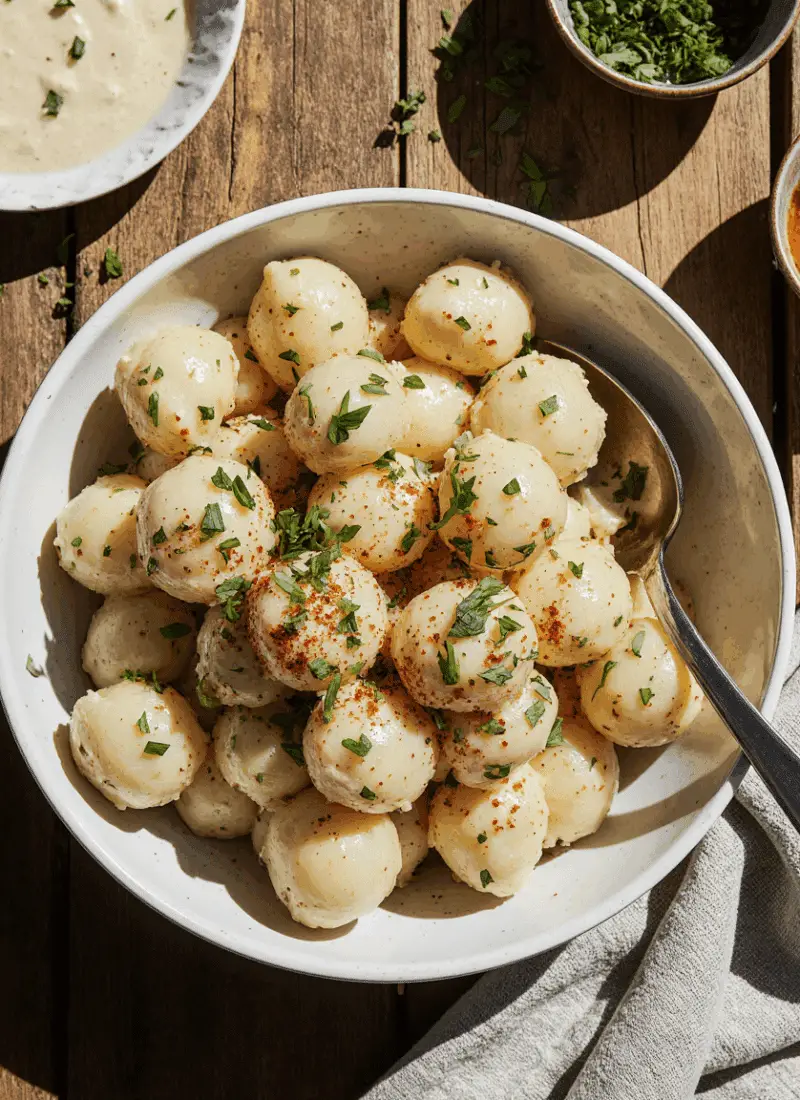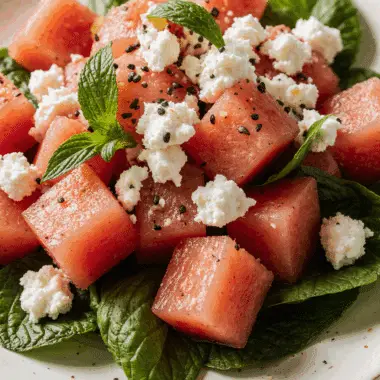This Classic Potato Salad is the quintessential side dish for picnics, barbecues, and summer get-togethers. Made with tender potatoes, crunchy celery, and zesty mustard dressing, it strikes the perfect balance between creamy and tangy. Whether you’re serving it alongside grilled meats or as a hearty stand-alone lunch, this comforting salad is sure to please every guest with its nostalgic, homestyle flavor.
FULL RECIPE
Ingredients
- 2 pounds (about 900g) Yukon Gold or red potatoes, peeled and cut into 1-inch chunks
- 1 cup mayonnaise
- 1 tablespoon yellow mustard
- 1 tablespoon Dijon mustard (optional, for extra tang)
- 2 teaspoons apple cider vinegar
- ½ teaspoon sugar
- Salt and black pepper, to taste
- 2 celery stalks, finely chopped
- ½ cup red onion, finely chopped
- 3 hard-boiled eggs, chopped
- ¼ cup chopped dill pickles or sweet relish (optional)
- 2 tablespoons chopped fresh parsley or dill (optional, for garnish)
Directions
- Cook the Potatoes: Place the peeled and chopped potatoes in a large pot. Cover with cold water and add a generous pinch of salt. Bring to a boil over medium-high heat and cook for about 10–12 minutes or until the potatoes are fork-tender but not mushy.
- Drain and Cool: Drain the potatoes and let them cool slightly. You can spread them out on a baking sheet for faster cooling.
- Make the Dressing: In a large bowl, whisk together the mayonnaise, yellow mustard, Dijon mustard (if using), apple cider vinegar, sugar, salt, and pepper. Taste and adjust seasoning as needed.
- Combine Ingredients: Add the cooled potatoes, celery, red onion, and chopped eggs to the dressing. Gently fold everything together until well coated.
- Optional Add-ins: Stir in chopped pickles or sweet relish for extra tang and crunch if desired.
- Chill: Cover the bowl with plastic wrap and refrigerate the salad for at least 1 hour before serving. This helps the flavors meld beautifully.
- Serve: Garnish with fresh herbs like parsley or dill just before serving for a fresh, colorful touch.
Nutrition Facts
- Calories: 310
- Total Fat: 21g
- Saturated Fat: 3.5g
- Cholesterol: 120mg
- Sodium: 370mg
- Total Carbohydrates: 25g
- Dietary Fiber: 2g
- Sugars: 3g
- Protein: 6g
- Vitamin C: 15% DV
- Calcium: 2% DV
- Iron: 6% DV
- Potassium: 620mg
The Appeal of Classic Potato Salad
Classic Potato Salad is beloved across generations and cultures for its rich texture and comforting taste. Its combination of soft potatoes, creamy dressing, and crunchy vegetables offers a satisfying mouthfeel and familiar flavor profile. It’s a staple at picnics, potlucks, and backyard barbecues, often evoking nostalgic memories of summer gatherings and family celebrations. The creamy base balances tanginess and sweetness, making it appealing to a wide range of palates and adaptable for various diets and flavor preferences.
Health Benefits of Potatoes in the Salad
Potatoes, the heart of this dish, are often underestimated for their nutritional value. They are an excellent source of complex carbohydrates, which provide sustained energy. Additionally, potatoes contain essential nutrients such as vitamin C, potassium, and vitamin B6. When boiled with the skin, they also offer fiber, which supports digestive health. Although the dish can be rich due to the dressing, the base ingredient itself is low in fat and cholesterol-free, offering a balanced foundation for a hearty side.
Nutritional Considerations and Modifications
While the traditional recipe includes mayonnaise and eggs, which add fat and cholesterol, the dish can be lightened without losing its creamy appeal. Greek yogurt or light sour cream can replace some or all of the mayonnaise to reduce saturated fat while boosting protein content. Dijon mustard and apple cider vinegar not only add tang but also help cut through the richness, keeping the salad flavorful without being heavy. For those with dietary restrictions, vegan mayonnaise and egg-free alternatives can be used to create a plant-based version.
Flavor Variations and Regional Twists
Potato salad varies significantly around the world. In the southern United States, it might include sweet pickle relish and a touch of sugar for a sweeter taste. German-style potato salad, by contrast, uses a vinegar-based dressing and is often served warm with bacon. In Scandinavian versions, dill and capers are popular additions. These variations offer endless opportunities to customize the flavor profile to suit personal preferences or cultural traditions while still honoring the essence of the dish.
Serving Suggestions and Presentation Ideas
Presentation plays a key role in elevating this classic dish. A sprinkle of paprika, freshly chopped herbs like dill or parsley, or even sliced green onions can enhance both the appearance and flavor. Serve it chilled in a glass or ceramic bowl to maintain its temperature and visual appeal. For picnics, individual mason jar servings are practical and charming. Garnishing just before serving ensures the herbs stay vibrant and adds a touch of freshness that contrasts beautifully with the creamy base.
Perfect Pairings for a Balanced Meal
Classic Potato Salad pairs well with a variety of dishes, making it a versatile side. It complements grilled meats such as chicken, steak, and sausages beautifully. For a lighter pairing, serve it with grilled fish or a garden vegetable platter. Its creamy richness also contrasts nicely with tangy or spicy main courses, helping to balance bold flavors. Including a crisp, acidic beverage like lemonade or iced tea can further cleanse the palate and complete the meal experience.
Make-Ahead and Storage Advice
One of the best aspects of potato salad is its make-ahead convenience. Preparing it a few hours or even a day in advance enhances the flavors as they have time to meld. It should be stored in an airtight container in the refrigerator and consumed within 3–4 days for optimal freshness and food safety. If serving outdoors, keep it chilled in a cooler or over a bowl of ice to prevent spoilage, especially in warmer temperatures. Avoid freezing, as the creamy dressing tends to separate upon thawing.
Common Mistakes to Avoid
To achieve the best texture and flavor, it’s important to avoid overcooking or undercooking the potatoes. Overcooked potatoes can turn mushy and make the salad watery, while undercooked ones leave an unpleasant, firm bite. It’s also essential to season the potatoes with salt during the boiling stage, as this enhances the overall taste. Another common pitfall is overdressing; adding too much mayonnaise or mixing the salad while the potatoes are too hot can result in an overly thick, gluey texture.
Kid-Friendly and Crowd-Pleasing Qualities
Potato salad’s mild, creamy flavor and familiar texture make it a favorite among children and picky eaters. The neutral base allows families to adjust seasoning levels and add-ins according to taste preferences. Kids may enjoy simpler versions without onions or pickles, while adults might prefer a more complex mix. Its appeal to a wide demographic makes it an ideal addition to buffets and gatherings where diverse age groups and dietary needs are present.
Seasonal Adaptability and Fresh Ingredient Swaps
Though often associated with summer, classic potato salad can be adapted for any season. In spring, adding peas, radishes, or asparagus gives it a fresh twist. During fall, roasted root vegetables like carrots or parsnips can be folded in for a hearty variation. Seasonal herbs, such as tarragon or chives, provide a way to keep the dish dynamic and aligned with the flavors of the moment. Swapping ingredients keeps the salad exciting while maintaining its core appeal.
Conclusion
Classic Potato Salad is more than just a side dish—it’s a comforting, versatile, and customizable staple that can be adapted for any occasion, dietary preference, or season. Whether you enjoy it as a nostalgic summer favorite or tweak it with modern health-conscious upgrades, its creamy-tangy profile continues to win hearts at every table.








